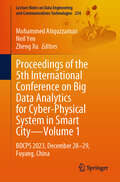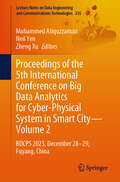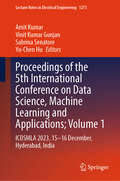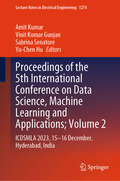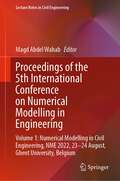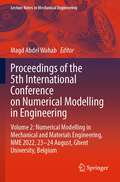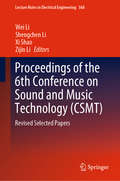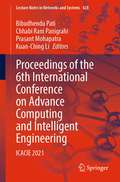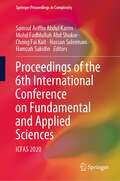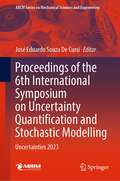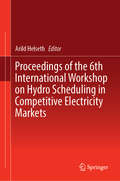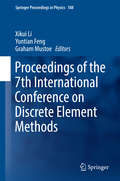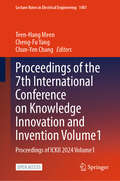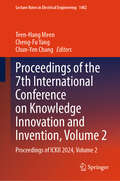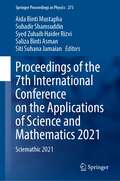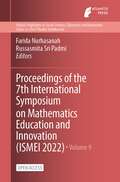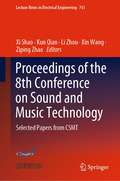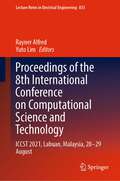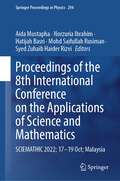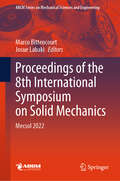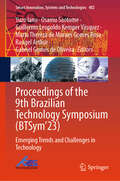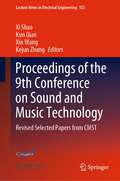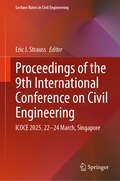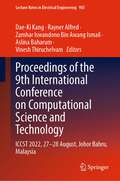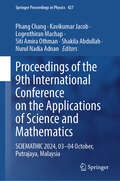- Table View
- List View
Proceedings of the 5th International Conference on Big Data Analytics for Cyber-Physical System in Smart City—Volume 1: BDCPS 2023, December 28–29, Fuyang, China (Lecture Notes on Data Engineering and Communications Technologies #234)
by Mohammed Atiquzzaman Zheng Xu Neil YenThis book gathers a selection of peer-reviewed papers presented at the 5th Big Data Analytics for Cyber-Physical System in Smart City (BDCPS 2023) conference, held in Fuyang, China, on December 28–29. The contributions, prepared by an international team of scientists and engineers, cover the latest advances and challenges made in the field of big data analytics methods and approaches for the data-driven co-design of communication, computing, and control for smart cities. Given its scope, it offers a valuable resource for all researchers and professionals interested in big data, smart cities, and cyber-physical systems.
Proceedings of the 5th International Conference on Big Data Analytics for Cyber-Physical System in Smart City—Volume 2: BDCPS 2023, December 28–29, Fuyang, China (Lecture Notes on Data Engineering and Communications Technologies #235)
by Mohammed Atiquzzaman Zheng Xu Neil YenThis book gathers a selection of peer-reviewed papers presented at the 5th Big Data Analytics for Cyber-Physical System in Smart City (BDCPS 2023) conference, held in Fuyang, China, on December 28–29. The contributions, prepared by an international team of scientists and engineers, cover the latest advances and challenges made in the field of big data analytics methods and approaches for the data-driven co-design of communication, computing, and control for smart cities. Given its scope, it offers a valuable resource for all researchers and professionals interested in big data, smart cities, and cyber-physical systems.
Proceedings of the 5th International Conference on Data Science, Machine Learning and Applications; Volume 1: ICDSMLA 2023, 15–16 December, Hyderabad, India (Lecture Notes in Electrical Engineering #1273)
by Amit Kumar Yu-Chen Hu Vinit Kumar Gunjan Sabrina SenatoreThis book (Volume 1) includes peer reviewed articles from the 5th International Conference on Data Science, Machine Learning and Applications, 2023, held at the G Narayanamma Institute of Technology and Sciences, Hyderabad on 15-16th December, India. ICDSMLA is one of the most prestigious conferences conceptualized in the field of Data Science & Machine Learning offering in-depth information on the latest developments in Artificial Intelligence, Machine Learning, Soft Computing, Human Computer Interaction, and various data science & machine learning applications. It provides a platform for academicians, scientists, researchers and professionals around the world to showcase broad range of perspectives, practices, and technical expertise in these fields. It offers participants the opportunity to stay informed about the latest developments in data science and machine learning.
Proceedings of the 5th International Conference on Data Science, Machine Learning and Applications; Volume 2: ICDSMLA 2023, 15–16 December, Hyderabad, India (Lecture Notes in Electrical Engineering #1274)
by Amit Kumar Yu-Chen Hu Vinit Kumar Gunjan Sabrina SenatoreThis book includes peer reviewed articles from the 5th International Conference on Data Science, Machine Learning and Applications, 2023, held at the G Narayanamma Institute of Technology and Sciences, Hyderabad on 15-16th December, India. ICDSMLA is one of the most prestigious conferences conceptualized in the field of Data Science & Machine Learning offering in-depth information on the latest developments in Artificial Intelligence, Machine Learning, Soft Computing, Human Computer Interaction, and various data science & machine learning applications. It provides a platform for academicians, scientists, researchers and professionals around the world to showcase broad range of perspectives, practices, and technical expertise in these fields. It offers participants the opportunity to stay informed about the latest developments in data science and machine learning.
Proceedings of the 5th International Conference on Numerical Modelling in Engineering: Volume 1: Numerical Modelling in Civil Engineering, NME 2022, 23-24 August, Ghent University, Belgium (Lecture Notes in Civil Engineering #311)
by Magd Abdel WahabThis book gathers outstanding papers on numerical modeling in Civil Engineering (Volume 1) as part of the 2-volume proceedings of the 5th International Conference on Numerical Modeling in Engineering (NME 2022), which was held in Ghent, Belgium, on 23-24 August 2022. The overall objective of the conference was to bring together international scientists and engineers in academia and industry from fields related to advanced numerical techniques, such as the finite element method (FEM), boundary element method (BEM), isogeometric analysis (IGA), etc., and their applications to a wide range of engineering disciplines. This volume covers numerical simulations with industrial civil engineering applications such as bridges and dams, cyclic loading, fluid dynamics, structural mechanics, geotechnical engineering, thermal analysis, reinforced concrete structures, steel structures, and composite structures. The book is intended for academics, including graduate students and researchers, as well as industrial practitioners working in the numerical modelling in civil engineering topics.
Proceedings of the 5th International Conference on Numerical Modelling in Engineering: Volume 2: Numerical Modelling in Mechanical and Materials Engineering, NME 2022, 23–24 August, Ghent University, Belgium (Lecture Notes in Mechanical Engineering)
by Magd Abdel WahabThis book gathers outstanding papers on numerical modeling in Mechanical Engineering (Volume 2) as part of the 2-volume proceedings of the 5th International Conference on Numerical Modeling in Engineering (NME 2021), which was held in Ghent, Belgium, on August 23–24, 2022. The overall objective of the conference was to bring together international scientists and engineers in academia and industry from fields related to advanced numerical techniques, such as the finite element method (FEM), boundary element method (BEM), isogeometric analysis (IGA), and their applications to a wide range of engineering disciplines. This book addresses numerical simulations of various mechanical and materials engineering industrial applications such as aerospace applications, acoustic analysis, bio-mechanical applications, contact problems and wear, heat transfer analysis, vibration and dynamics, transient analysis, nonlinear analysis, composite materials, polymers, metal alloys, fracture mechanics, fatigue of materials, creep, mechanical behavior, micro-structure, phase transformation, and crystal plasticity. The book is intended for academics, including graduate students and researchers, as well as industrial practitioners working in the numerical modeling in mechanical engineering topics.
Proceedings of the 6th Conference on Sound and Music Technology: Revised Selected Papers (Lecture Notes in Electrical Engineering #568)
by Wei Li Shengchen Li Xi Shao Zijin LiThis book discusses the use of advanced techniques to produce and understand music in a digital way. It gathers the first-ever English-language proceedings of the Conference on Sound and Music Technology (CSMT), which was held in Xiamen, China in 2018. As a leading event, the CSMT reflects the latest advances in acoustic and music technologies in China. Sound and technology are more closely linked than most people assume. For example, signal-processing methods form the basis of music feature extraction, while mathematics provides an objective means of representing current musicological theories and discovering new ones. Moreover, machine-learning methods include popular deep learning algorithms and are used in a broad range of contexts, from discovering patterns in music features to producing music. As these proceedings demonstrate, modern technologies not only offer new ways to create music, but can also help people perceive sound in innovative new ways.
Proceedings of the 6th International Conference on Advance Computing and Intelligent Engineering: ICACIE 2021 (Lecture Notes in Networks and Systems #428)
by Kuan-Ching Li Bibudhendu Pati Chhabi Rani Panigrahi Prasant MohapatraThis book gathers high-quality research papers presented at the 6th International Conference on Advanced Computing and Intelligent Engineering (ICACIE 2021) organized by Bhubaneswar Institute of Technology, Bhubaneswar, Odisha, India, during December 23–24, 2021. It includes sections describing technical advances and the latest research in the fields of computing and intelligent engineering. Intended for graduate students and researchers working in the disciplines of computer science and engineering, the proceedings also appeal to researchers in the field of electronics, as they cover hardware technologies and future communication technologies.
Proceedings of the 6th International Conference on Fundamental and Applied Sciences: ICFAS 2020 (Springer Proceedings in Complexity)
by Samsul Ariffin Abdul Karim Mohd Fadhlullah Abd Shukur Chong Fai Kait Hassan Soleimani Hamzah SakidinThis book highlights latest advancement in Mathematics, Physics and Chemistry. With the theme of “Innovative Science towards Sustainability and Industrial Revolution 4.0”, ICFAS 2020 brings together leading experts, scientific communities and industrialists working in the field of applied sciences and mathematics from all over the world to share the most recent developments and cutting-edge discoveries addressing sustainability and industrial revolution 4.0 in the field. The conference topics include green materials, molecular modelling, catalysis, nanodevices and nanosystems, smart materials applications, solar cells technology, computational mathematics, data analysis and visualization, and numerical analysis. The contents of this book are useful for researchers, students, and industrial practitioners in the areas of Mathematics, Physics and Chemistry as most of the topics are in line with IR 4.0.
Proceedings of the 6th International Symposium on Uncertainty Quantification and Stochastic Modelling: Uncertainties 2023 (Lecture Notes in Mechanical Engineering)
by José Eduardo Souza De CursiThis proceedings book covers a wide range of topics related to uncertainty analysis and its application in various fields of engineering and science. It explores uncertainties in numerical simulations for soil liquefaction potential, the toughness properties of construction materials, experimental tests on cyclic liquefaction potential, and the estimation of geotechnical engineering properties for aerogenerator foundation design. Additionally, the book delves into uncertainties in concrete compressive strength, bio-inspired shape optimization using isogeometric analysis, stochastic damping in rotordynamics, and the hygro-thermal properties of raw earth building materials. It also addresses dynamic analysis with uncertainties in structural parameters, reliability-based design optimization of steel frames, and calibration methods for models with dependent parameters. The book further explores mechanical property characterization in 3D printing, stochastic analysis in computational simulations, probability distribution in branching processes, data assimilation in ocean circulation modeling, uncertainty quantification in climate prediction, and applications of uncertainty quantification in decision problems and disaster management. This comprehensive collection provides insights into the challenges and solutions related to uncertainty in various scientific and engineering contexts.
Proceedings of the 6th International Workshop on Hydro Scheduling in Competitive Electricity Markets
by Arild HelsethThis book includes a collection of research articles presented at the “6th International Workshop on Hydro Scheduling in Competitive Electricity Markets”. The workshop was a unique and intimate forum for researchers and practitioners to present state-of-the-art research and development concerning novel methodological findings, best practices and real-life applications of hydro scheduling. It also provided a platform for discussing the developments that are taking place in the industry, sharing different experiences and discussing future trends related to this area. This proceedings book is a collection of the most relevant, high-quality articles from the workshop. Discussing the state-of-the-art in the field of hydro scheduling, it is a valuable resource for a wide audience of researchers and practitioners in the field now and in the interesting and challenging times ahead.
Proceedings of the 7th International Conference on Discrete Element Methods
by Xikui Li Yuntian Feng Graham MustoeThis book presents the latest advances in Discrete Element Methods (DEM) and technology. It is the proceeding of 7th International Conference on DEM which was held at Dalian University of Technology on August 1 - 4, 2016. The subject of this book are the DEM and related computational techniques such as DDA, FEM/DEM, molecular dynamics, SPH, Meshless methods, etc. , which are the main computational methods for modeling discontinua. In comparison to continua which have been already studied for a long time, the research of discontinua is relatively new, but increases dramatically in recent years and has already become an important field. This book will benefit researchers and scientists from the academic fields of physics, engineering and applied mathematics, as well as from industry and national laboratories who are interested in the DEM.
Proceedings of the 7th International Conference on Knowledge Innovation and Invention, Volume 1: Proceedings of ICKII 2024, Volume 1 (Lecture Notes in Electrical Engineering #1481)
by Cheng-Fu Yang Teen-Hang Meen Chun-Yen ChangThis volume represents the proceedings of the 7th International Conference on Knowledge Innovation and Invention 2024 (ICKII 2024). This conference is organized by IEEE Tainan Section Sensors Council, National Formosa University of Taiwan, and International Institute of Knowledge Innovation and Invention (IIKII), and held on August 16-18, 2024, in Nagoya, Aichi, Japan. The conference provided a unified communication platform for researchers in a range of topics, such as information technology, communication science & engineering, computer science, electrical & electronic engineering, automation engineering, big data computation, machine learning, and other engineering related fields. This proceedings volume enables interdisciplinary collaboration of science and engineering technologists in the academic and industrial fields, as well as networking internationally. This book is open access, which means that you have free and unlimited access
Proceedings of the 7th International Conference on Knowledge Innovation and Invention, Volume 2: Proceedings of ICKII 2024, Volume 2 (Lecture Notes in Electrical Engineering #1482)
by Cheng-Fu Yang Teen-Hang Meen Chun-Yen ChangThis volume represents the proceedings of the 7th International Conference on Knowledge Innovation and Invention 2024 (ICKII 2024). This conference is organized by IEEE Tainan Section Sensors Council, National Formosa University of Taiwan, and International Institute of Knowledge Innovation and Invention (IIKII), and held on August 16-18, 2024, in Nagoya, Aichi, Japan. The conference provided a unified communication platform for researchers in a range of topics, such as information technology, communication science & engineering, computer science, electrical & electronic engineering, automation engineering, big data computation, machine learning, and other engineering related fields. This proceedings volume enables interdisciplinary collaboration of science and engineering technologists in the academic and industrial fields, as well as networking internationally.
Proceedings of the 7th International Conference on the Applications of Science and Mathematics 2021: Sciemathic 2021 (Springer Proceedings in Physics #273)
by Aida Binti Mustapha Suhadir Shamsuddin Syed Zuhaib Haider Rizvi Saliza Binti Asman Siti Suhana JamaianThis book presents peer-reviewed articles and recent advances on the potential applications of Science and Mathematics for future technologies, from the 7th International Conference on the Applications of Science and Mathematics (SCIEMATHIC 2021), held in Malaysia. It provides an insight about the leading trends in sustainable Science and Technology. The world is looking for sustainable solutions to problems more than ever. The synergistic approach of mathematicians, scientists and engineers has undeniable importance for future technologies. With this viewpoint, SCIEMATHIC 2021 has the theme “Quest for Sustainable Science and Mathematics for Future Technologies”. The conference brings together physicists, mathematicians, statisticians and data scientists, providing a platform to find sustainable solutions to major problems around us. The works presented here are suitable for professionals and researchers globally in making the world a better and sustainable place.
Proceedings of the 7th International Symposium on Mathematics Education and Innovation (Atlantis Highlights in Social Sciences, Education and Humanities #9)
by Farida Nurhasanah Russasmita Sri PadmiThis is an open access book.Numeracy has become the current buzzword in the world of Indonesian mathematics education since the Ministry of Education and Culture, Research and Technology of the Republic of Indonesia (Kemdikbudristek-RI) launched the Minimum Competency Assessment (Asesmen Kompetensi Minimum - AKM) program. Together with literacy, numeracy is the minimum competency measured in the AKM. This policy is expected to foster a learning culture that places students as the main focus, as well as the shift of the paradigm from simply teaching the content, to developing the students’ competence in a constructive and adaptive manner.Currently, there are still many mathematics teachers who are not familiar with numeracy, which is followed by various misconceptions and misinformation. One of the efforts of the SEAMEO Regional Centre for QITEP in Mathematics or commonly called SEAQiM in supporting teacher professionalism is through the International Symposium on Mathematics Education and Innovation (ISMEI). This symposium is initiated by SEAQiM and is held every two years. This activity is a space for disseminating works and exchanging ideas about innovations in mathematics education for teachers, education staff, policy makers, and related stakeholders.In 2022, ISMEI will be held for the seventh time with the theme being Transforming Education by Reimaging Numeracy Learning. Through this theme, ISMEI invites education practitioners to transform education by reviewing mathematics learning practices to develop numeracy and discussing its potential in the future.
Proceedings of the 8th Conference on Sound and Music Technology: Selected Papers from CSMT (Lecture Notes in Electrical Engineering #761)
by Xin Wang Xi Shao Kun Qian Li Zhou Ziping ZhaoThe book presents selected papers at the 8th Conference on Sound and Music Technology (CSMT) held in November 2020, at Taiyuan, Shanxi, China. CSMT is a multidisciplinary conference focusing on audio processing and understanding with bias on music and acoustic signals. The primary aim of the conference is to promote the collaboration between art society and technical society in China. In this proceeding, the paper included covers a wide range topic from speech, signal processing, music understanding, machine learning and signal processing for advanced medical diagnosis and treatment applications; which demonstrates the target of CSMT merging arts and science research together.its content caters to scholars, researchers, engineers, artists, and education practitioners not only from academia but also industry, who are interested in audio/acoustics analysis signal processing, music, sound, and artificial intelligence (AI).
Proceedings of the 8th International Conference on Computational Science and Technology: ICCST 2021, Labuan, Malaysia, 28–29 August (Lecture Notes in Electrical Engineering #835)
by Rayner Alfred Yuto LimThis book gathers the proceedings of the Seventh International Conference on Computational Science and Technology (ICCST 2021), held in Labuan, Malaysia, on 28–29 August 2021. The respective contributions offer practitioners and researchers a range of new computational techniques and solutions, identify emerging issues, and outline future research directions, while also showing them how to apply the latest large-scale, high-performance computational methods.
Proceedings of the 8th International Conference on the Applications of Science and Mathematics: SCIEMATHIC 2022; 17—19 Oct; Malaysia (Springer Proceedings in Physics #294)
by Syed Zuhaib Haider Rizvi Aida Mustapha Norzuria Ibrahim Hatijah Basri Mohd Saifullah RusimanThis book presents peer-reviewed articles and recent advances on the potential applications of Science and Mathematics for future technologies, from the 8th International Conference on the Applications of Science and Mathematics (SCIEMATHIC 2022), held in Malaysia. It provides an insight about the leading trends in sustainable Science and Technology. Topics included in this proceedings are in the areas of Mathematics and Statistics, including Natural Science, Engineering and Artificial Intelligence.
Proceedings of the 8th International Symposium on Solid Mechanics: Mecsol 2022 (Lecture Notes in Mechanical Engineering)
by Marco Bittencourt Josue LabakiThis book presents the proceedings of Mecsol 2022. The papers cover multidisciplinary topics, including Fatigue and Failure Analyses; Composite Materials and Structures; Elasticity, Plasticity, Damage and Fracture Mechanics; Viscoelasticity and Viscoplasticity; Impact Engineering; Structural Reliability Methods and Reliability-Based Design Optimization; Optimization of Materials, Fluids and Structures; Numerical Methods; Nonlinear Analyses; High-Performance Computing applied to Solid Mechanics; and Artificial Intelligence- and Neural Network-supported applications.
Proceedings of the 9th Brazilian Technology Symposium: Emerging Trends and Challenges in Technology (Smart Innovation, Systems and Technologies #402)
by Yuzo Iano Rangel Arthur Osamu Saotome Gabriel Gomes de Oliveira Guillermo Leopoldo Kemper Vásquez Maria Thereza de Moraes Gomes RosaThis book presents the proceedings of the 9th Brazilian Technology Symposium (BTSym'23). The book discusses current technological issues on Systems Engineering, Mathematics, and Physical Sciences, such as the Transmission Line, Protein-Modified Mortars, Electromagnetic Properties, Clock Domains, Chebyshev Polynomials, Satellite Control Systems, Hough Transform, Watershed Transform, Blood Smear Images, Toxoplasma Gondi, Operation System Developments, MIMO Systems, Geothermal-Photovoltaic Energy Systems, Mineral Flotation Application, CMOS Techniques, Frameworks Developments, Physiological Parameters Applications, Brain–Computer Interface, Artificial Neural Networks, Computational Vision, Security Applications, FPGA Applications, IoT, Residential Automation, Data Acquisition, Industry 4.0, Cyber-Physical Systems, Digital Image Processing, Patters Recognition, Machine Learning, Photocatalytic Process, Physical-Chemical Analysis, Smoothing Filters, Frequency Synthesizers, VoltageControlled Ring Oscillator, Difference Amplifier, Photocatalysis, and Photodegradation, and current technological issues on Human, Smart, and Sustainable Future of Cities, such as the Digital Transformation, Data Science, Hydrothermal Dispatch, Project Knowledge Transfer, Immunization Programs, Efficiency and Predictive Methods, PMBOK Applications, Logistics Process, IoT, Data Acquisition, Industry 4.0, Cyber-Physical Systems, Fingerspelling Recognition, Cognitive Ergonomics, Ecosystem Services, Environmental, Ecosystem Services valuation, Solid Waste, and University Extension.
Proceedings of the 9th Conference on Sound and Music Technology: Revised Selected Papers from CMST (Lecture Notes in Electrical Engineering #923)
by Xin Wang Xi Shao Kun Qian Kejun ZhangThe book presents selected papers at the 9th Conference on Sound and Music Technology (CSMT) held virtually in June 2022, organized by Zhejiang University, China. CSMT is a multidisciplinary conference focusing on audio processing and understanding with bias on music and acoustic signals. The primary aim of the conference is to promote the collaboration between art society and technical society in China. In this book, the paper included covers a wide range topic from speech, signal processing, music understanding, machine learning, and signal processing for advanced medical diagnosis and treatment applications, which demonstrates the target of CSMT merging arts and science research together. Its content caters to scholars, researchers, engineers, artists, and education practitioners not only from academia but also industry, who are interested in audio/acoustics analysis signal processing, music, sound, and artificial intelligence (AI).
Proceedings of the 9th International Conference on Civil Engineering: ICOCE 2025, 22–24 March, Singapore (Lecture Notes in Civil Engineering #714)
by Eric J. StraussThis book comprises the latest collection of peer reviewed research articles presented at the 9th International Conference on Civil Engineering, ICOCE 2025, held in Singapore from March 22 to 24. The proceedings focus on the state-of-the-art findings on topics of civil engineering and related fields. Engineering solutions are treated from a global perspective. Highlighted fields of inquiry include concrete technology, computer simulations, construction and engineering management, building materials, and architecture and urban planning. The authors outline solutions to physical, natural resource, and economic problems in many different contexts. This volume consists of refereed articles authored by a wide variety of international researchers and practitioners from many perspectives discussing current research solutions that involve problems in civil and environmental engineering. Examples that cover municipal development, transportation engineering, pollution control, and public safety are prominently featured. The chapters contain a diverse collection of applications that appeal to individuals with all levels of knowledge and interest in the important issues relevant to international engineering.
Proceedings of the 9th International Conference on Computational Science and Technology: ICCST 2022, 27–28 August, Johor Bahru, Malaysia (Lecture Notes in Electrical Engineering #983)
by Rayner Alfred Dae-Ki Kang Zamhar Iswandono Bin Awang Ismail Aslina Baharum Vinesh ThiruchelvamThis book gathers the proceedings of the 9th International Conference on Computational Science and Technology (ICCST 2022), held in Johor Bahru, Malaysia, on August 27–28, 2022. The respective contributions offer practitioners and researchers a range of new computational techniques and solutions, identify emerging issues, and outline future research directions, while also showing them how to apply the latest large-scale, high-performance computational methods.
Proceedings of the 9th International Conference on the Applications of Science and Mathematics: SCIEMATHIC 2024, 03-04 October, Putrajaya, Malaysia (Springer Proceedings in Physics #427)
by Kavikumar Jacob Phang Chang Logenthiran Machap Siti Amira Othman Shakila Abdullah Nurul Nadia AdnanThis book presents peer-reviewed articles and highlights successful examples of integrating science and mathematics for future global initiatives from the 9th International Conference on the Applications of Science and Mathematics (SCIEMATHIC 2024), held in Malaysia. It provides knowledge exchange between experts in the fields of science and mathematics that promotes harmony and holistic understanding for future generations. Topics included in this proceeding are mathematics and statistics, physics, chemistry, engineering sciences, and artificial intelligence.
